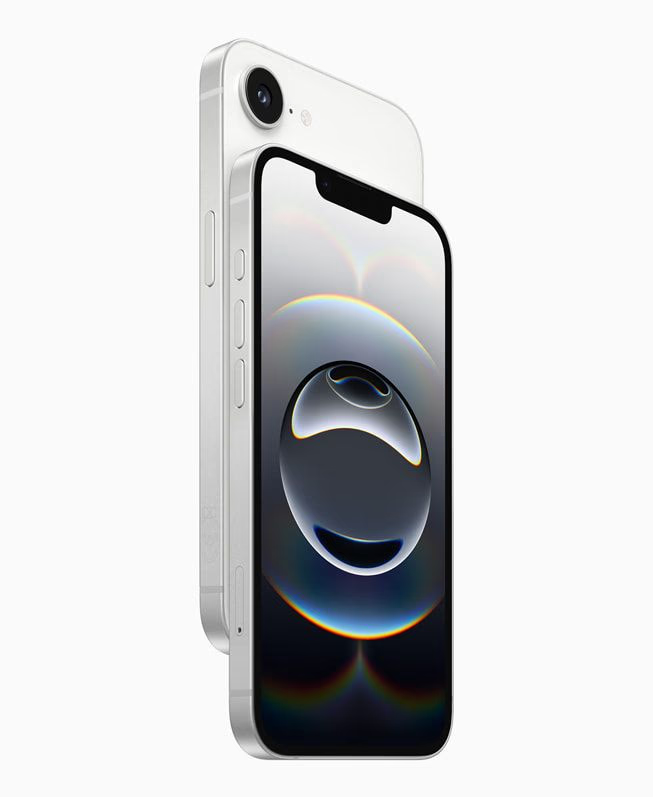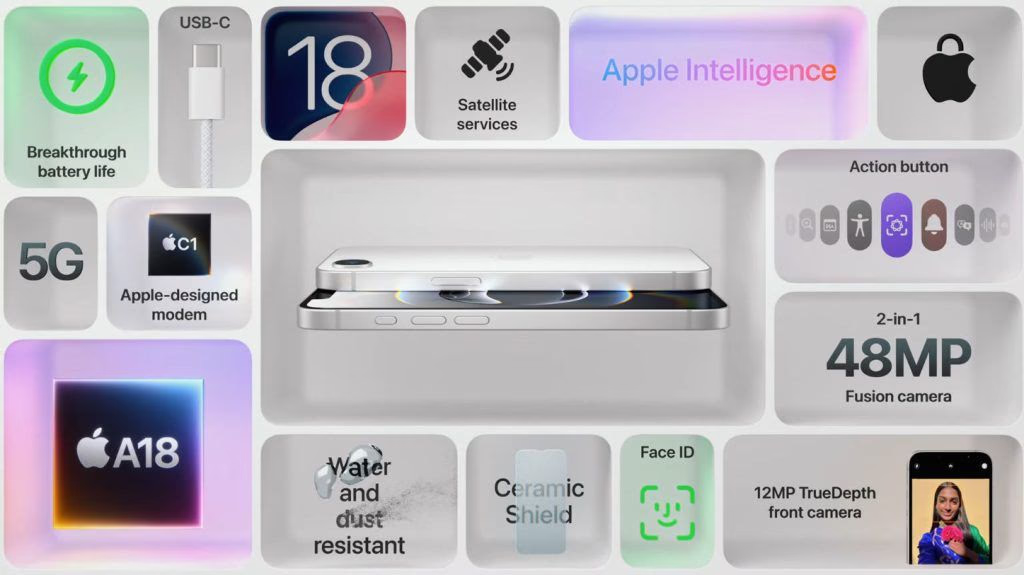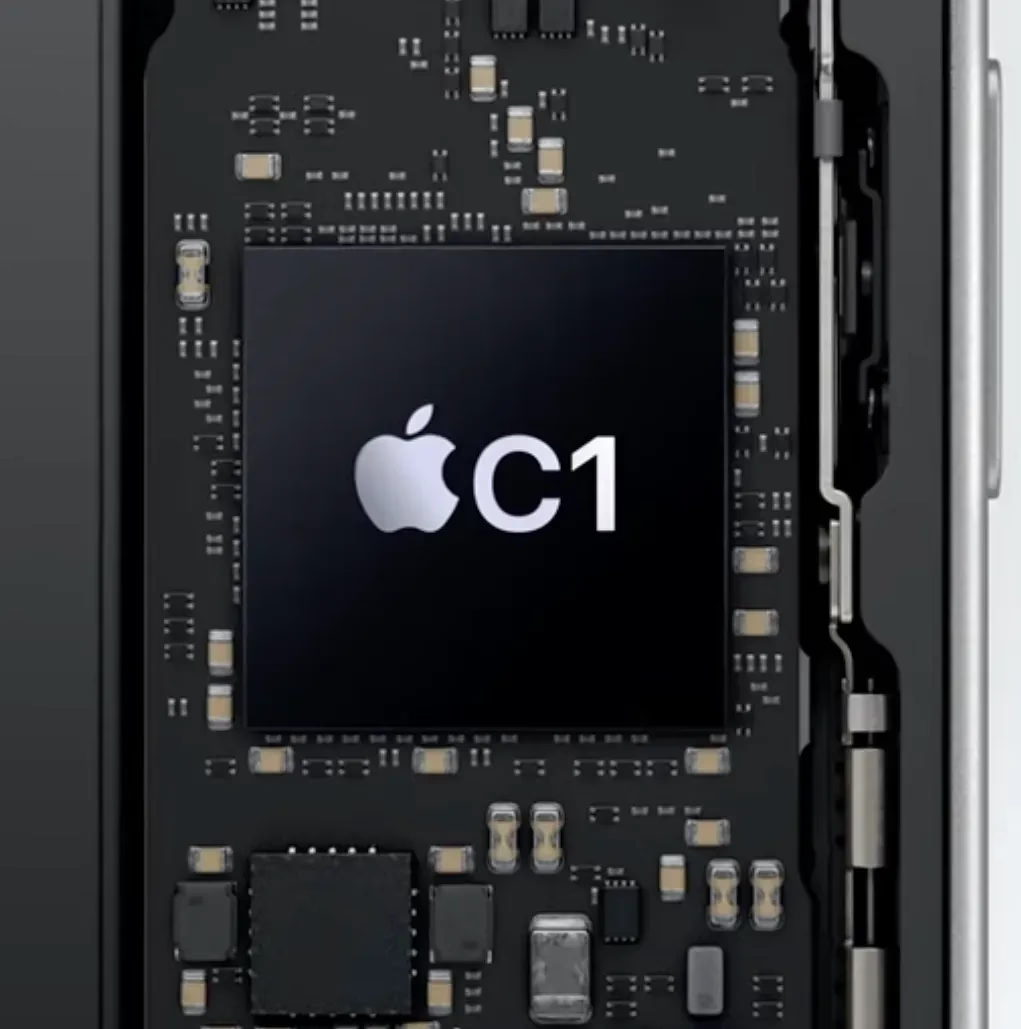
Apple is shaking up the smartphone market once again with the release of the iPhone 16e. To call it simply “budget-friendly” would be an understatement; the iPhone 16e carries significant weight. The fresh design, beefed-up performance, and, most importantly, the inclusion of Apple’s in-house C1 modem chip are seen by analysts as potentially game-changing moments for Apple’s future strategy. Let’s break down the technical, market, and strategic implications of the iPhone 16e launch, paying special attention to the role of the C1 modem in Apple’s broader vision.
🎨 Design Innovation with a Strategic Twist: Redefining “Entry-Level”
The most immediately noticeable change in the iPhone 16e is undoubtedly its design. The 6.1-inch Super Retina XDR OLED display is a huge upgrade compared to the LCD on older SE models, and the inclusion of the notch design and Face ID, even in an entry-level lineup, is noteworthy.
Doing away with the Touch ID home button, practically a trademark of the iPhone SE series, signals Apple’s commitment to incorporating current design trends even in its more affordable models.

The aerospace-grade aluminum frame, Ceramic Shield front glass, and IP68 water and dust resistance rating – specs usually reserved for premium models – are definite selling points. However, the pricing – starting at $599 for the 128GB model, and jumping to $899 for the 512GB version – is already getting some flack for being higher than previous SE models.
Ultimately, the iPhone 16e’s design changes are less about creating a “cheap iPhone” and more about delivering a “premium experience at a reasonable price.” By using the same design language across its lines, even in the entry-level space, Apple aims to shake off the perception of recycling old parts, increase customer satisfaction, and expand its reach to a wider audience. You can definitely sense Apple’s ambition here.
🤖 C1 Modem: A Key Driver for Apple Ecosystem Expansion

The real innovation to watch in the iPhone 16e is the C1 modem. As Apple’s first custom-designed cellular modem chip, the C1 replaces Qualcomm components in the iPhone 16e. Apple is touting the C1 as “the most power-efficient modem in iPhone history,” and early benchmarks suggest a 20-25% reduction in power consumption compared to the Qualcomm X70 modem. This should translate into longer battery life, which is always a win.
Of course, it’s a bit of a bummer that the C1 modem doesn’t support some legacy protocols like mmWave 5G and DC-HSDPA. But Apple’s ambitions with the C1 modem go far beyond mere performance gains. The prevailing view is that the C1 modem will allow Apple to reduce its reliance on Qualcomm and, in the long run, optimize hardware and software integration, strengthening the Apple ecosystem even further.

Just as Apple transitioned Macs from Intel chips to its own Apple Silicon, the company is aiming to take complete control of product development by designing even core iPhone components like the modem chip in-house. The goal is to accelerate the pace of innovation, further differentiate itself from the competition, and ultimately create a virtuous cycle that maximizes user experience. The C1 modem is the first piece of that puzzle and a sign of things to come for Apple’s ecosystem expansion.
💰 Pricing Controversy and Apple’s Big Picture
The pricing strategy for the iPhone 16e has been a hot topic even before its release. A starting price of $599 isn’t exactly cheap, especially compared to the discontinued iPhone SE ($429) or even flagship models from other manufacturers.
There are concerns that the iPhone 16e’s higher price could hurt sales in price-sensitive markets like India. In fact, the iPhone 16e 128GB model is reportedly selling for 59,900 rupees (around $720 USD) in India, which is a pretty significant price tag.

So why did Apple price the iPhone 16e higher than the SE model? There are a few strategic reasons we can speculate on. First, Apple may want to emphasize that the iPhone 16e isn’t just “entry-level” but a model that offers a “premium” experience. With specs comparable to flagships, like the A18 chip, improved cameras, OLED display, and support for the latest AI features like Apple Intelligence, the price is justified accordingly.
Second, Apple might be willing to accept a degree of “cannibalization” of iPhone 15 sales with the iPhone 16e. While the iPhone 15 has features like MagSafe, Ultra Wideband (UWB), and a 120Hz ProMotion display, the iPhone 16e’s newer chipset and AI capabilities could make it an appealing alternative for consumers who are hesitant to pay the premium price for flagship models. Ultimately, this could increase overall iPhone sales and create a more diverse lineup with a wider range of options for consumers.
Third, from a long-term perspective, development costs for the C1 modem, rising design and component costs, etc. might have made the $599 price point unavoidable for Apple. Apple might be trying to achieve profitability with the iPhone 16e while simultaneously validating the performance of the C1 modem and laying the groundwork for expanding the use of its own modem in future flagship models. In the end, the pricing controversy surrounding the iPhone 16e offers a glimpse into Apple’s “big picture,” which prioritizes long-term strategy and future market competitiveness over short-term sales figures.
🔮 iPhone 16e: A Game Changer That Will Reshape the Future of the Smartphone Market?
The release of the iPhone 16e is more than just the addition of a new iPhone model; it also hides Apple’s grand ambition of achieving complete independence in mobile AP-modem chips. The C1 modem is just the beginning, and Apple is expected to continue developing next-generation modems to improve performance and expand their use to flagship models. The next-generation modem, expected to be released in 2026, is expected to add mmWave support and compete head-to-head with the Qualcomm X80.
If Apple succeeds in becoming self-sufficient with modem chips, the smartphone market could be reshaped in a completely different way. Apple could reduce the enormous licensing fees it pays to Qualcomm and invest those savings in product innovation or price competitiveness. Furthermore, it would be able to optimize hardware and software integration much more tightly than it does now, providing an overwhelming user experience that competitors would find difficult to replicate.
Furthermore, the C1 modem is likely to be expanded to the entire Apple ecosystem, including MacBooks, iPads, Apple Watches, and AirPods, not just iPhones. This means that the C1 modem could play a key role in maximizing connectivity between Apple devices and creating new convergent services. In particular, it is possible to secure connectivity by installing its own modem in MacBook Air and MacBook Pro models that do not have cellular models.
Of course, Apple’s journey toward modem chip independence has many hurdles to overcome. There are endless aspects to verify, such as the C1 modem’s actual performance, stability, and compatibility with global telecommunications networks. However, as Apple has demonstrated in the past with the successful development of Apple Silicon, it is possible that telecommunications chipsets will also become independent in the long term. It remains to be seen whether the iPhone 16e and C1 modem will be the first step toward Apple’s long-term ambition of “chip independence” and a harbinger of a paradigm shift in the future smartphone market.